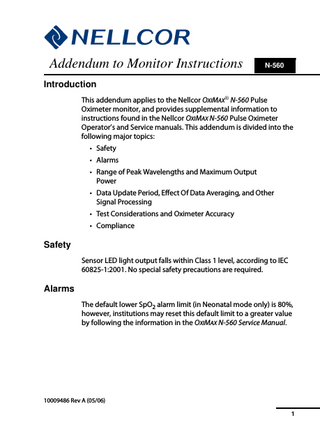Addendum
4 Pages

Preview
Page 1
1
Addendum to Monitor Instructions
N-560
Introduction This addendum applies to the Nellcor OXIMAX® N-560 Pulse Oximeter monitor, and provides supplemental information to instructions found in the Nellcor OXIMAX N-560 Pulse Oximeter Operator’s and Service manuals. This addendum is divided into the following major topics: • Safety • Alarms • Range of Peak Wavelengths and Maximum Output Power • Data Update Period, Effect Of Data Averaging, and Other Signal Processing • Test Considerations and Oximeter Accuracy • Compliance
Safety Sensor LED light output falls within Class 1 level, according to IEC 60825-1:2001. No special safety precautions are required.
Alarms The default lower SpO2 alarm limit (in Neonatal mode only) is 80%, however, institutions may reset this default limit to a greater value by following the information in the OXIMAX N-560 Service Manual.
10009486 Rev A (05/06) 1
Addendum to Monitor Instructions
Range of Peak Wavelengths and Maximum Output Power Electrical/Optical Specifications
Nellcor pulse oximetry sensors contain light emitting diodes (LEDs) that emit red light at a wavelength of approximately 660 nm and infrared light at a wavelength of approximately 900 nm. The total optical output power of the sensor LEDs is less than 15 mW. This information may be useful to clinicians, such as those performing photodynamic therapy.
Data Update Period, Effect Of Data Averaging, and Other Signal Processing There are various matrices within the N-560 algorithm. Some of these are used to assess the severity of conditions presented to the N-560 measuring SpO2 and pulse rate on a patient. These individual matrices or combinations of these matrices are used to drive the LED indicators on the N-560 front panel. The advanced signal processing in the algorithms automatically extends the amount of data required for measuring SpO2 and pulse rate depending on the measuring conditions. During normal measurement conditions, the averaging time is six to seven seconds (approximately three seconds in Fast Mode). The N-560 automatically adjusts the signal processing during degraded conditions such as those caused by low perfusion, interference, (e.g. external interference such as ambient light, electromagnetic interference, and patient motion), or a combination of these, which results in an increase in the dynamic averaging beyond the minimum as set by the response mode. (Refer to the N-560 Operator’s Manual for more information on Setting the Response Mode.) If the result of the dynamic averaging time exceeds 20 seconds for SpO2, the PULSE SEARCH indicator is illuminated solid, and the SpO2 and pulse rate will continue to be updated every second. As these conditions extend, the amount of data required continues to increase. If the dynamic averaging time for SpO2 reaches 40 seconds, and/or 50 seconds for Pulse Rate, a low priority alarm state results: The pulse search indicator begins flashing, the 10009486 Rev A (05/06) 2
Addendum to Monitor Instructions
SpO2 and pulse rate displays flash zeros indicating a loss of pulse condition and an audible alarm state is activated. Blip Bar Pulse Amplitude Indicator
The Blip Bar Pulse Amplitude Indicator indicates pulse beat and shows the relative (non-normalized) pulse amplitude. As the detected pulse becomes stronger, more bars light up with each pulse. This indicator is only available in the blip view. Plethysmographic Waveform Display
Similarly, when a Plethysmographic Waveform is selected, the display provides the (non-normalized) real-time sensor signal. The relative pulsatile strength and quality of the incoming signal can be observed.
Test Considerations and Oximeter Accuracy Functional Testers and Patient Simulators
Some models of commercially available bench top functional testers and patient simulators can be used to verify the proper functionality of Nellcor pulse oximeter sensors, cables and monitors. See the individual testing device's operator's manual for the procedures specific to the model of tester being used. While such devices may be useful for verifying that the pulse oximeter sensor, cable, and monitor are functional, they are incapable of providing the data required to properly evaluate the accuracy of a system's SpO2 measurements. Fully evaluating the accuracy of the SpO2 measurements requires, at a minimum, accommodating the wavelength characteristics of the sensor and reproducing the complex optical interaction of the sensor and the patient’s tissue. These capabilities are beyond the scope of known bench top testers, including known devices which claim to measure sensor LED wavelength. SpO2 measurement accuracy can only be evaluated in vivo by comparing pulse oximeter readings with values traceable to SaO2
10009486 Rev A (05/06) 3
Addendum to Monitor Instructions
measurements obtained from simultaneously sampled arterial blood made using a laboratory CO-oximeter. Many functional testers and patient simulators have been designed to interface with the pulse oximeter's expected calibration curves and may be suitable for use with Nellcor monitors and/or sensors. Not all such devices, however, are adapted for use with the Nellcor OXIMAX digital calibration system. While this will not affect use of the simulator for verifying system functionality, displayed SpO2 measurement values may differ from the setting of the test device. For a properly functioning monitor, this difference will be reproducible over time and from monitor to monitor within the performance specifications of the test device. Accuracy with Low Perfusion
Reading accuracy in the presence of low perfusion (detected IR pulse modulation amplitude 0.03% - 1.5%) was validated using signals supplied by a patient simulator. SpO2 and pulse rate values were varied across the monitoring range over a range of weak signal conditions and compared to the known true saturation and pulse rate of the input signals.
Compliance When used with Nellcor OXIMAX sensors and the appropriate Nellcor pulse oximetry cable, the Nellcor OXIMAX N-560 Pulse Oximeter is compliant with ISO 9919:2005 with the following exceptions: Clause 50.101
See “Data Update Period, Effect Of Data Averaging, and Other Signal Processing” on page 2 of this document. Clause 201.5.4.1
See “Alarms” on page 1 of this document.
10009486 Rev A (05/06) 4